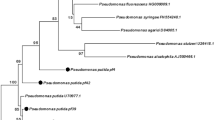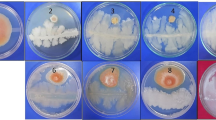Abstract
Fluorescent pseudomonads are one of the most important microbial communities which play a key role in rhizosphere to enhance plant growth-promotion and protection. The diverse groups of antibiotics viz. 2,4-diacetylphloroglucinol (DAPG), phenazine-1-carboxylic acid (PCA) and pyoluteorin (PLT) are produced by fluorescent pseudomonads inhibiting growth of fungal pathogens which results in health upliftment of plants. The present study, discusses about frequency and diversity of 138 antibiotic-producing fluorescent pseudomonads isolated from eight genotypes of rapeseed mustard rhizosphere (Brassica juncea L. Czern.). The plant growth promoting traits and antibiotics (DAPG, PCA and PLT) production of isolates were examined by using polymerase chain reaction (PCR), thin layer chromatography (TLC) and dot blot-hybridization. Among 138 isolates, 47, 25 and 9 % of isolates were positive in indole production, phosphate solubilization and antagonism potential against Sclerotinia sclerotiorum (causal agent of white mold disease in rapeseed mustard), respectively. PCR amplifications showed that none of the isolates had phlD (DAPG) and phzC (PCA) genes, but four isolates (UKA-2, UKA-8, UKA-11, UKA-66) had pltB (PLT) gene, which was further confirmed by TLC and DNA dot-blot hybridization. BOX profiles of pltB positive isolates were distinct, showing unique genetic diversity in the small population. The four pltB positive fluorescent pseudomonad isolates could be used as promising bio-control and plant growth-promoting inoculants for Indian rapeseed mustard.





Similar content being viewed by others
Abbreviations
- FP:
-
Fluorescent pseudomonads
- IRM:
-
Indian rapeseed mustard
- DAPG:
-
2,4-Diacetyl phloroglucinol
- PCA:
-
Phenazine-1-carboxylic acid
- PLT:
-
Pyoluteorin
References
de La Fuente L, Mavrodi DV, Landa BB, Thomashow LS (2006) phlD-based genetic diversity and detection of genotype of 2,4-diacytylphloroglucinol-producing Pseudomonas fluorescens. FEMS Microbiol Ecol 50:64–78
Weller DM, Mavrodi DV, van Pelt JA, Pieterse CM, van Loon LC, Bakker PA (2012) Induced systemic resistance in Arabidopsis thaliana against Pseudomonas syringae pv. tomato by 2,4-diacetyl phloroglucinol producing Pseudomonas fluorescens. Phytopathology 102:403–412
Liu H, Dong D, Peng H, Zhang X, Xu Y (2006) Genetic diversity of phenazine-and pyoluteorin-producing pseudomonads isolated from green pepper rhizosphere. Arch Microbiol 185(2):91–98
Ramette A, Frapolli M, Fischer-Le Saux M, Gruffaz C, Meyer JM, Défago G, Sutra L, Moenne-Loccoz Y (2011) Pseudomonas protegens sp. nov., widespread plant-protecting bacteria producing the biocontrol compounds 2,4-diacetyl phloroglucinol and pyoluteorin. Syst Appl Microbiol 34:180–188
Mavrodi DV, Mavrodi OV, Parejko JA, Bonsall RF, Kwak YS, Paulitz TC, Thomashow LS, Weller DM (2012) Accumulation of the antibiotic phenazine-1-carboxylic acid in the rhizosphere of dryland cereals. Appl Environ Microbiol 78:804–812
Barto EK, Antunes PM, Stinson K, Koch AM (2011) Differences in arbuscular mycorrhizal fungal communities associated with sugar maple seedlings in and outside of invaded garlic mustard forest patches. Biol Invasions 13(12):2755–2762
Vierheilig H, Bennett R, Kiddle G, Kaldorf M, Ludwig-Müller J (2000) Differences in glucosinolate patterns and arbuscular mycorrhizal status of glucosinolate-containing plant species. New Phytol 146(2):343–352
Lemanceau P, Corberand T, Gardan L, Latour X (1995) Effect of two plant species, flax (Linum usitatissimum L.) and tomato (Lycopersicon esculentum Mill.) on the diversity of soil-borne populations of fluorescent pseudomonads. Appl Environ Microbiol 61:1004–1012
Landa BB, Mavrodi OV, Raaijmakers JS, Gardener BBM (2002) Differential ability of genotype of 2,4-diacetyl phloroglucinol producing Pseudomonas fluorescens strains to colonize the roots of pea plants. Appl Environ Microbiol 68:3226–3237
Rao MS, Dwivedi MK, Tiwari SP, Kumar RM, Rajinikanth R, Chaya MK, Grace GN, Priti K, Ratnamma M, Kamalnath M, Prabu P, Vidyashree N, Gopalkrishna C, Shivananda TN (2014) Documentation of bio-efficacy of DAPG producing Pseudomonas fluorescens-1% as on Meloidogyne incognita and Ralstonia solanacearum infecting tomato in different agro-climatic regions. Pest Manag Horticult Ecosyst 20(2):222–226
de Souza JT, Weller DM, Raaijmakers JM (2003) Frequency, diversity and activity of 2,4-diacetylphloroglucinol-producing fluorescent Pseudomonas spp. in Dutch take-all decline soils. Phytopathology 93:54–63
Weller DM (2015) Take-all decline and beneficial pseudomonads. In: Principles of plant–microbe interactions. Springer, New York, pp 363–370
King EO, Ward MK, Raney DE (1954) Two simple media for demonstration of pyocyanin and fluroscein. J Lab Clin Med 44:301–307
Bric JM, Bostock RM, Silverstone SE (1991) Rapid in situ assay for Indoleacetic acid production by bacteria immobilized on a nitrocellulose membrane. Appl Environ Microbiol 57:535–538
Pikovskya RI (1948) Mobilization of phosphorus and soil in connection with the vital activity of some microbial species. Microbiology 17:362–370
Masterson RV, Prakash RK, Amerly AG (1985) Conservation of symbiotic nitrogen fixation gene sequence in R. japonicum. J Bacteriol 163:21–26
Raaijmakers JM, Weller DM, Thomashow LS (1997) Frequency of antibiotic producing Pseudomonas spp. in natural environments. Appl Environ Microbiol 63:881–887
Mavrodi OJ, Gardener BBM, Mavrodi DN, Bansall RF (2001) Genetic diversity of phlD from 2,4-diacetylphloroglucinol producing fluorescent Pseudomonas spp. Phytopathology 91:35–43
Udo EE, Dashti AA (2000) Detection of genes encoding aminoglycoside-modifying enzymes in staphylococci by polymerase chain reaction and dot blot hybridization. Int J Antimicrob Agents 13(4):273–279
Picard C, Bosco M (2005) Maize heterosis affects the structure and dynamics of indigenous rhizospheric auxins-producing Pseudomonas populations. FEMS Microbiol Ecol 53:349–357
Ottaviani D, Masini L, Bacchiocchi S (2003) A biochemical protocol for the isolation and identification of current species of Vibrio in seafood. J Appl Microbiol 95(6):1277–1284
Rohlf FJ (2000) NTSYS-pc: numerical taxonomy system. Ver. 2.1. Exeter Publishing, Ltd., Setauket
Costa R, Gotz M, Mrotzek N, Lottmann J (2006) Effects of site and plant species on rhizosphere community structure as revealed by molecular analysis of microbial guilds. FEMS Microbiol Ecol 56:236–249
Berg G, Zachow C, Lottmann J, Gotz M (2005) Impact of plant species and site on rhizosphere associated fungi antagonistic to Verticillum dahliae kleb. Appl Environ Microbiol 71:4203–4213
Kumar U, Lakkineni VK, Kannepalli K (2013) Antagonistic potential and functional diversity of endo- and rhizospheric bacteria of basmati rice. Oryza 50(2):162–168
Kumar U, Mishra S (2014) Functional and genetic diversity of primary and secondary- metabolites producing fluorescent pseudomonads from rhizosphere of rice (Oryza sativa L.). J Appl Zool Res 25:83–93
Asghar H, Zahir Z, Arshad M, Khaliq A (2002) Relationship between in vitro production of auxins by rhizobacteria and their growth-promoting activities in Brassica juncea L. Biol Fert Soils 35:231–237
Mazurier S, Corberand T, Lemanceau P, Raaijmakers JM (2009) Phenazine antibiotics produced by fluorescent pseudomonads contribute to natural soil suppressiveness to Fusarium wilt. ISME J 3(8):977–991
Haas G, Keel C (2003) Regulation of antibiotic production in root-colonizing Pseudomonas spp. and relevance for biological control of plant disease. Annu Rev Microbiol 41:117–153
Bergsma-Vlami M, Prins ME, Raaijmakers JM (2005) Influence of plant species on populations dynamics genotype diversity and antibiotic production in the rhizosphere by indigenous Pseudomonas spp. FEMS Microbiol Ecol 52:59–69
Raaijmakers JM, Vlami M, de Souza JT (2002) Antibiotic production by bacterial biocontrol agents. Ant Van Leewen 81:537–547
Landa BB, Mavrodi OV, Raaijmakers JS, Gardener BBM (2002) Differential ability of genotype of 2,4-diacetyl phloroglucinol producing Pseudomonas fluorescens strains to colonize the roots of pea plants. Appl Environ Microbiol 68:3226–3237
Raaijmakers JM, Bonsall RF, Weller DM (1999) Effect of population diversity of Pseudomonas fluorescens on production of 2,4-diacetyl phloroglucinol in the rhizosphere of wheat. Phytopathology 89:470–475
Acknowledgments
The first author thanks to Indian Council of Agricultural Research (ICAR) and Indian Agricultural Research Institute, New Delhi, India for providing financial assistance in the form of Junior Research Fellowship (JRF) and laboratory facility of conducting research work, respectively.
Author information
Authors and Affiliations
Corresponding author
Ethics declarations
Conflict of interest
All authors declares that there are no conflicts of interest.
Rights and permissions
About this article
Cite this article
Kumar, U., Panneerselvam, P., Banik, A. et al. Lower Frequency and Diversity of Antibiotic-Producing Fluorescent Pseudomonads in Rhizosphere of Indian Rapeseed–Mustard (Brassica juncea L. Czern.). Proc. Natl. Acad. Sci., India, Sect. B Biol. Sci. 88, 579–586 (2018). https://doi.org/10.1007/s40011-016-0792-1
Received:
Revised:
Accepted:
Published:
Issue Date:
DOI: https://doi.org/10.1007/s40011-016-0792-1




